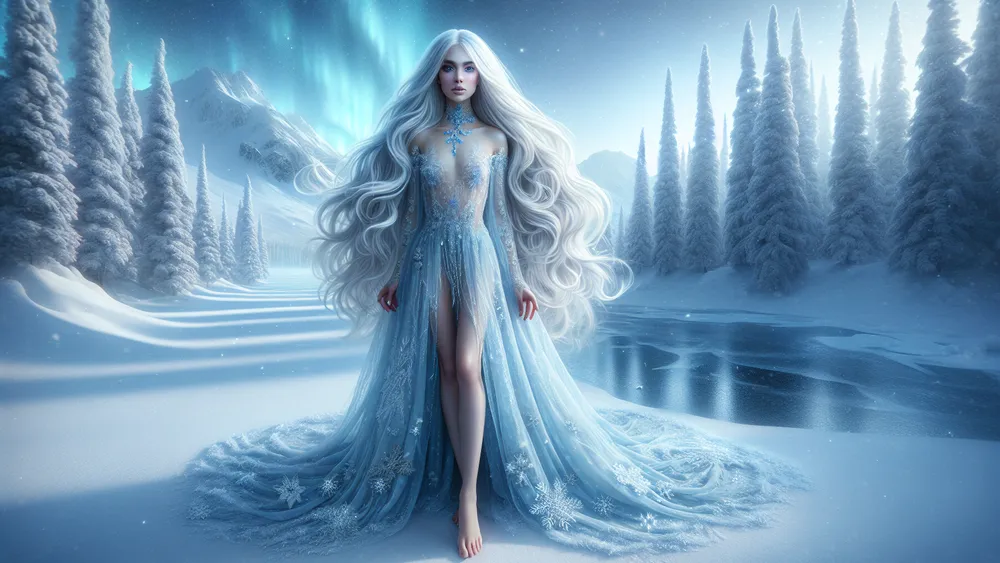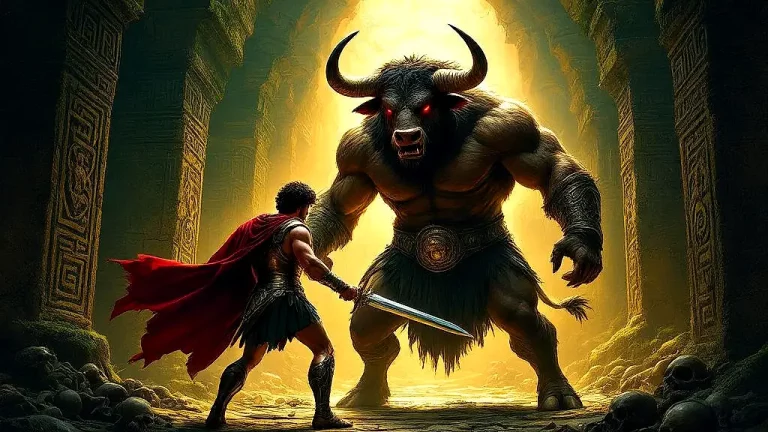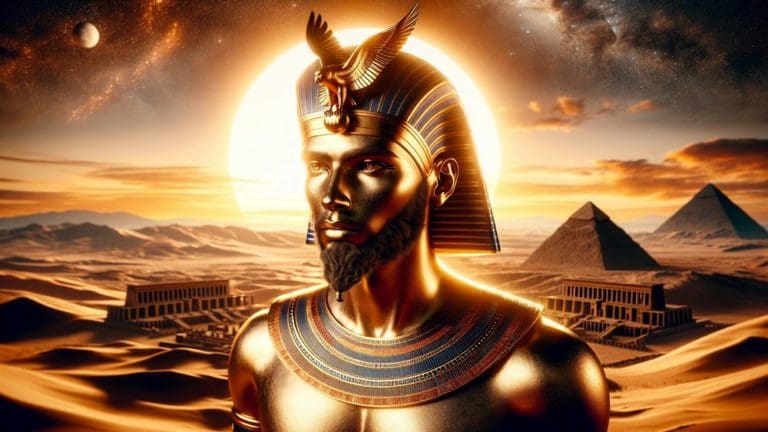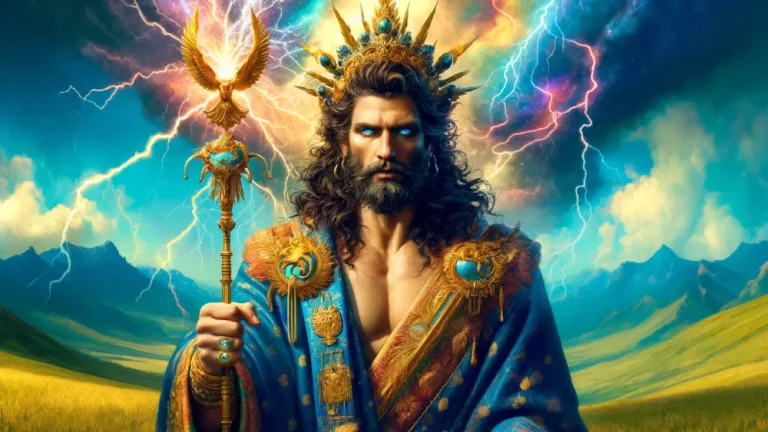Khione: Goddess Of Snow In Greek Mythology
In the big and complex history of Greek myths, the gods and goddesses each have their own areas and stories that have interested people for a long time. One of them is Khione, the snow goddess. Her presence is like the first snow of winter. Imagine a place covered in pure white snow, each flake being a small work of art – this area belongs to Khione.
Key Points:
- Khione is the Greek goddess of snow and winter.
- She is the daughter of Boreas, the god of the North Wind, and Oreithyia, an Athenian princess.
- Khione’s role in Greek myths includes controlling snow and winter, symbolizing change and the power of nature.
- Important stories include her talks with Poseidon, her involvement with the Argonauts, and her impact on Greek mythology.
- Symbols linked to Khione include snowflakes and white doves, representing purity, change, and peace.
- Ancient Greeks honored Khione through rare festivals and offerings, seeking her favor during winter.
- Khione is compared to other winter gods like Skadi, Morana, and Demeter, each representing different aspects of winter and nature.
You will learn about Khione’s origins. She is from Boreas, a strong wind god, and Oreithyia, a princess. Moreover, you will read about her role in many stories, her talks with gods like Poseidon and Pan, and her impact on famous people like the Argonauts.
We will also look at the symbols linked to Khione, like snowflakes and white doves, and how the old Greeks honored her with parties and gifts. Additionally, comparing her to other winter gods like Skadi and Morana will give us a better idea of her special place in myth stories.
Lastly, we will think about the themes of change and nature’s power in Khione’s stories, offering lessons for today. So, let us go on this trip through the cold worlds of Greek stories and find out about Khione, the snow goddess.
Khione: Overview and Key Facts
| Key Point | Description |
|---|---|
| Name | Khione (also spelled Chione) |
| Area | Goddess of Snow and Winter |
| Parents | Boreas (god of the North Wind) and Oreithyia (Athenian princess) |
| Siblings | Zetes, Calais, Cleopatra, and Chione (different person) |
| Important Stories | Talks with Poseidon causing Eumolpus to be born; joining the Argonauts |
| Icon | Snowflakes, White Dove |
| Appreciation | Celebrated through events and gifts, but less than others |
| Similar Deities | Skadi (Norse stories), Morana (Slavic stories), Demeter (Greek myths) |
| Themes | Change, Transformation, Power of Nature |
| Today’s Importance | Shows the beauty and harshness of winter, showing the two sides of nature |
Who is Khione?
To get to know Khione, we need to look into her beginnings and the stories that show who she is. So first, her family and the important parts she plays in Greek myths will be talked about.
Where She Comes From and Her Family Tree
Khione’s beginnings are tied to the strong and detailed family relationships in Greek myths. She is the daughter of Boreas, the strong god of the North Wind, and Oreithyia, an Athenian princess who was taken by Boreas to be his queen. This union puts Khione in a special place among myths, giving her both divine and royal connections. Looking at her close family helps us understand her connections:
- Boreas: God of the North Wind, known for his cold, strong gusts.
- Oreithyia: Athenian princess, made a goddess when she married Boreas.
- Zetes and Calais: Khione’s brothers, part of the Argonauts, a group of known heroes.
- Cleopatra: Khione’s sister, with her own mythological importance.
This family tree shows Khione’s divine roots and connects her to many important figures and stories within Greek myths, which makes her story richer and more influential.
Khione’s family ties in Greek mythology give her divine and royal connections, linking her to key figures and stories in Greek myths.
What She Does in Greek Myths
Khione is the goddess who controls snow and winter, which gives her a special role in Greek myths. She represents the cold, quiet beauty of snow and the changing power of winter. A first snowfall can change how a place looks, turning it into a place covered in snow. This change is shown by Khione in myths, often showing a shift in nature.
Moreover, she can control snow and ice, making her strong. Both sides of her power show the unpredictable side of winter, gentle or fierce.
Khione’s importance is also shown by her talks with other gods and her parts in different myths. For instance, she had a vital talk with Poseidon, the god of the sea, which resulted in the birth of Eumolpus, an essential figure in Greek stories. Additionally, Khione’s ties with Pan, the god of nature, show her link to nature and its cycles. These talks not only stress her importance but also place her story in the larger story of Greek mythology. Some of the main stories with Khione include:
- Encounter with Poseidon: Showing the birth of Eumolpus
- Relationship with Pan: Stressing her link to nature
- Involvement with the Argonauts: Changing their known trip
Through these stories, Khione’s role as the goddess of snow and winter is clearly shown, showing her influence and the respect she has among gods and people.

Stories and Tales
Now that we know Khione’s role and importance, it is time to look into some of the most interesting stories and tales that show this amazing goddess.
The Story of Eumolpus
In one of the interesting stories with Khione, she meets Poseidon, the powerful god of the sea. From their union, Eumolpus is born, a figure with great importance in Greek myths. To keep her newborn son safe from her father Boreas, Khione put Eumolpus into the sea, where Poseidon saved and raised him.
Eumolpus grew up to be a respected priest of Poseidon and a famous king of Thrace. He played a critical role with his actions and lineage since he later joined the Eleusinian Mysteries, which were key religious rites in ancient Greece.
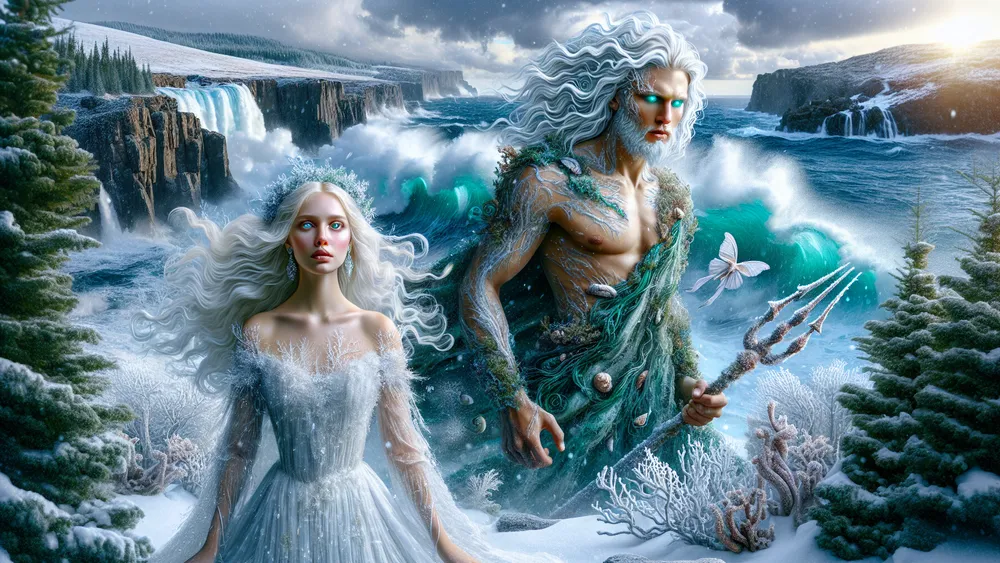
This story shows Khione’s role as a mother and also shows how the gods and their children were connected in making mythological stories.
Khione and the Argonauts
In the big story about the Argonauts, Khione has a small but important role. As the goddess of snow, she could affect the weather, which was key for the Argonauts on their dangerous trip to get the Golden Fleece. Khione could make snowstorms and handle winter elements, to both help and challenge the heroes.
For example, they were trapped in a bad storm, and when Khione stepped in, she calmed the winds so they could go on safely. She helped and hindered them. This story shows Khione’s power, showing her as a god with powers that both gods and mortals respected and feared.
Symbols and What They Mean
Now that we have looked at Khione’s stories and her impact in different myths, let’s now look into the symbols linked with her and what they stand for. They are important.
Snowflakes
Snowflakes are a typical symbol of Khione that show her control over snow and winter. Each snowflake, with its unique and complex design, shows the goddess’s skill in creating beauty and complexity in cold nature. In stories, people see snowflakes as Khione’s gentle but powerful touch that can change landscapes into snowy ones. People think snowflakes stand for purity, change, and the short-lived nature of life, all traits linking to Khione’s essence. To understand why they matter, think about these points:
- Uniqueness: Just as no two snowflakes are alike, Khione’s influence is unique in each myth.
- Transformation: Snowflakes change the world like Khione can change the seasons and weather.
- Purity: The pure nature of snowflakes reflects Khione’s link with untouched, natural beauty.
This shows Khione’s role in Greek stories, highlighting her as a god whose presence is both gentle and strong.
White Dove
The white dove is a vital symbol of Khione, showing purity, peace, and change, like the goddess. In Greek myths, a white dove is often seen as a messenger of the gods, showing divine steps and calmness. For Khione, the dove’s pure white feathers are like the untouched snow she controls, showing her ability to bring calm and beauty to the cold winter.
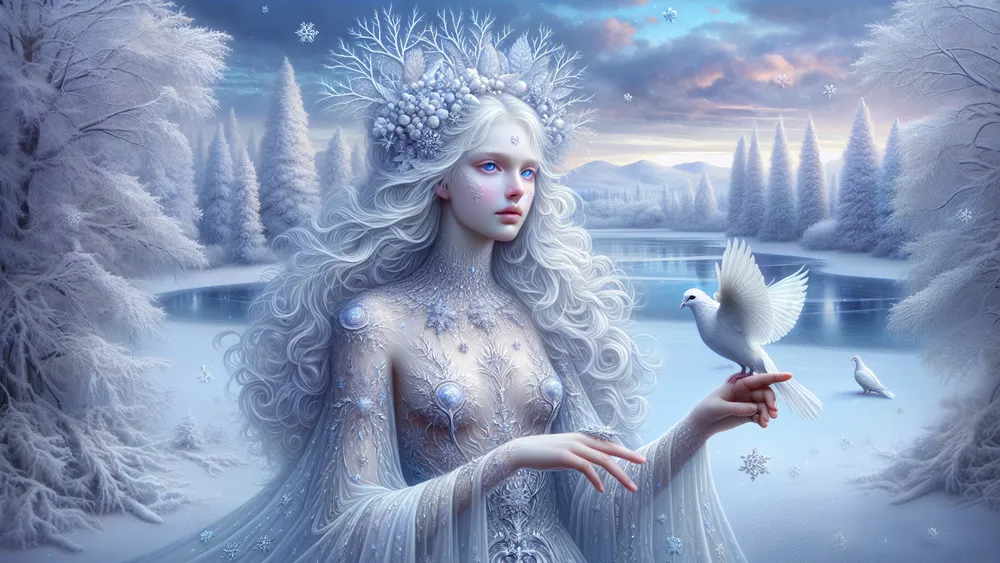
The dove’s calm nature and part in stories as a bringer of peace and new starts fit well with Khione’s sway over the natural world. Similar to how a white dove can mean hope and newness, Khione’s presence in myths often shows a big change, turning empty areas into calm, snow-covered lands. This link shows her role as a god who brings peace and big changes to the world.
The white dove symbolizes purity, peace, and change, mirroring the goddess Khione’s ability to bring calm and transformation to the world.
Worship and How People Honored Her
Now that we looked at the symbols linked with Khione, let’s look at how the ancient Greeks revered and respected her. How did they do this exactly? Look at their practices and rituals, and how these actions show their deep respect. They did many things.
Festivals and Offerings
In ancient Greece, festivals for Khione were rare but important, often during winter months to respect her control over snow and cold. Rituals and ceremonies were part of these celebrations aimed at calming the goddess and making sure winter is mild. Offerings made to Khione usually included simple items that showed purity and change, like white flowers, snow-like crystals, and small dove sculptures. These offerings were believed to seek her favor and create a peaceful balance in nature. To understand more about these offerings, think about these kinds:
- White Flowers: That represent purity and the clean nature of snow.
- Snow-like Crystals: Showing the cold and beautiful side of winter.
- Dove Sculptures: Reflecting peace and change, key parts of Khione.
These festivals and offerings show the respect ancient Greeks had for Khione, recognizing her power and seeking her help during tough winter times.

Temples and Altars
Temples and altars for Khione, while not as many as those for other gods, were made to show her calm and strong nature. They often had white marble and sparkly structures, symbolizing the purity and cold beauty of snow. Mainly in areas with harsh winters, like Thrace and the northern parts of Greece, these temples blended with the snowy places.
The altars, with carvings of snowflakes and doves, were focus points for offerings and prayers. Imagine a chapel with big windows for natural light, creating a calm and reflective feeling – this is like how Khione’s temples were meant to make people feel calm and respectful.
These building features and their places showed how much the ancient Greeks respected Khione, wanting her favor and protection during winter.
Comparing Her to Other Winter Gods
Now that we have looked at how people worshipped Khione, we will now look at her and compare her to other winter gods from different stories. This should be interesting.
Skadi
Khione, the Greek goddess of snow, and Skadi, the Norse goddess of winter, both show the harsh and beautiful parts of the cold season, yet their myths and roles show important differences. Mainly linked to snow and winter weather, Khione is often shown as a calm and otherworldly figure who brings snow to the earth. By contrast, Skadi is tough and a giant, known for her link to mountains, skiing, and hunting with a bow. While Khione’s stories usually involve her dealings with other gods, such as Poseidon and Pan, Skadi’s stories are more about her revenge on the gods of Asgard and her later marriage to the sea god Njord. Additionally, comparing their key aspects highlights these differences:
| Aspect | Khione (Greek) | Skadi (Norse) |
|---|---|---|
| Domain | Snow and Winter | Winter, Mountains, Skiing, Hunting |
| Key Attributes | Calm, Otherworldly, She Brings Snow | Tough, Hunter, Giant |
| Notable Myths | Dealings with Poseidon and Pan | Revenge on Asgard, Marriage to Njord |
| Cultural Significance | Symbol of winter’s beauty and purity | Symbol of winter’s harshness and strength |
These distinctions show how various cultures personified the forces of winter. While Khione shows the gentle, changing power of snow, Skadi represents the wild and harsh parts of the winter wilderness.
Morana
Khione, the Greek goddess of snow, and Morana, the Slavic goddess of winter and death, both show the tough parts of the cold season, yet their parts in stories and importance are different. Khione is mostly about the beauty and purity of snow, while she is often shown as a calm figure who brings the changing power of winter.
However, Morana shows the harshness of winter and the certainty of death, often shown as a scary figure who announces the end of life and the start of rebirth.
Mostly, Khione’s stories focus on how she deals with other gods and her role in bringing snow; meanwhile, the stories about Morana highlight her role in the death and rebirth cycle, marking the end of the old year and the start of the new. Moreover, to understand their importance better, think of Khione as showing the gentle, changing parts of winter, like a snowfall that covers the earth.
On the other hand, Morana stands for the harsh, unyielding fact of death and the promise of new life, like a tough winter that eventually gives way to spring. These representations show how different cultures see and represent the forces of winter and death, with Khione standing for winter’s beauty and Morana for its strong end and rebirth.
Demeter
Khione, the goddess of snow, and Demeter, the goddess of agriculture, both have important roles in the seasons, yet their areas and stories show different parts of nature. Linked with the start of winter, Khione brings snow and cold, marking a time when nature rests and changes.
Demeter, on the other hand, is linked to the growth of crops and the earth’s productivity, especially during spring and summer. Their stories join in the bigger picture of seasonal change: Khione’s arrival marks winter’s start, whereas Demeter’s sadness over her daughter Persephone being taken by Hades explains why winter months are barren, as she pulls her growth from the earth.
Interestingly, their stories differ in focus – Khione’s myths often show her dealings with other gods and her role in bringing snow, whereas Demeter’s main story centers on life and death cycles, shown by Persephone’s yearly return from the underworld.
Consider their roles simply: Khione is the sign of winter starting and changing, like the first snowfall that signals the season’s change, while Demeter is the force behind spring and summer’s growth, like flowers blooming and crops ripening. These roles show how ancient Greeks understood nature’s rhythms, with Khione and Demeter representing the balance between rest and growth.
What We Can Learn from Khione’s Stories
Now that we have compared Khione’s stories to those of other winter deities, now let’s look into the important things we learn from her myths.
Themes of Change and Transformation
Khione’s stories are full of themes about change and transformation, which show the shift from autumn to winter and the changing power of snow. In Greek mythology, the start of winter happens with Khione’s arrival, at that time there is a big change in the landscape, which gets covered in snow and ice.
This change can be viewed as personal growth and life shifts, where times of rest and thinking often come before new starts. For modern readers, Khione’s stories show us that change, even if it’s hard, is a natural part of life. Just like the earth needs rest and renewal in the winter months, we too must have times of change to grow and transform.
Consider Khione’s snow a cover that hides the old, letting the new come out, much like how big changes in our lives lead to new chances and views. These ever-relevant ideas tell us today that change is not an end, but a necessary part of our journey.
The Power of Nature
Khione’s stories show clearly the huge power of nature, using the pictures of snow and winter. In Greek mythology, the power of nature can be seen when Khione uses her power to cover the world in snow, which shows how nature can change the land, stop people, and make us respect it.
These stories teach us that natural forces are both beautiful and powerful, like a snowstorm that looks nice but is dangerous. For modern readers, Khione’s stories show the importance of respecting and understanding nature. Just as ancient Greeks prepared for the harshness of winter, we must acknowledge nature’s power in our lives, whether it’s through climate change, natural disasters, or the changing seasons.

Consider Khione’s snow to be a symbol of nature’s unpredictable and uncontrollable parts, which remind us that despite our progress, we are still subject to nature’s power. These stories encourage us to respect nature more deeply, knowing its power and learning to live in harmony with its cycles and forces.
Pantheon of Greek Mythology Gods
The group of Greek mythology Gods is a huge and complex mix of gods and goddesses, each with their own special traits, stories, and areas. From the mighty Zeus who rules over the gods, to the gentle Hestia, the goddess of the hearth. The Greek gods and goddesses include many powers and duties.
To see the full range of this interesting group, you can refer to this list of all the Greek gods, which gives an overview of these gods. You might consider the Greek group a big family, each one playing a major part in the cosmic order and human life, providing many stories and lessons that have interested people for a long time.
FAQs
1. What is Khione known for?
Khione is known for being the Greek goddess of snow and winter.
2. What is Khione’s family background?
Khione’s family background includes her parents Boreas, the god of the north wind, and Oreithyia, a mortal princess.
3. What is Khione’s role in Greek mythology?
Khione’s role in Greek mythology is primarily as the goddess of snow and winter.
4. Is Khione still worshipped today?
Khione is not widely worshipped today, but she remains a figure of interest in modern interpretations of Greek mythology.

